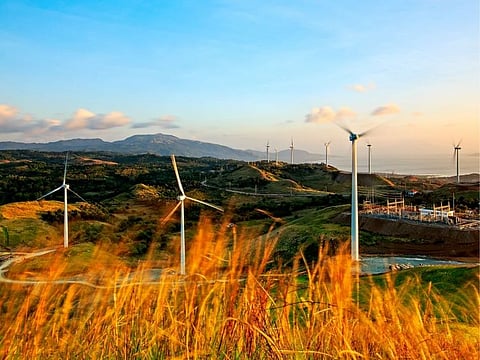Philippines: 300% growth seen in renewable energy
State pension fund GSIS pours Php1.45 billion into renewables company Alternergy

Manila: The Philippines’ renewable energy sector is set to grow nearly 300 per cent in the next five years in generating capacity, according to an industry estimate.
The Philippines' renewable energy market, estimated at 8,000 MW by end-2023, is projected to jump nearly three-fold to 22,158 MW in the next five years (by 2028) — a compounded annual growth rate of 22.6 per cent during the period, according to a Mordor forecast.
In a significant move, the Asian country has opened the renewable power sector to 100 per cent foreign ownership.
Local investors, meanwhile, are also active in taking positions in the green power sector.
On Tuesday, the Government Service Insurance System (GSIS), a state-run pension fund, has bought Php1.45 billion (about $25 million) worth of shares in Alternergy Holdings Corp. through a private placement.
GSIS’s investment was announced during a signing ceremony at the GSIS headquarters in Pasay City, led by GSIS President and General Manager Jose Arnulfo Veloso and Alternergy Chairman Vince Pérez Jr.
The latest development could precipitate a massive rollout of projects in the country’s push toward sustainable energy.
A 2018 study has ranked the Philippines as the world's most progressive renewable energy nation for the third year running.
Leap in renewables
The most commonly used sources of renewable energy in the Philippines are hydro and geothermal. As of 2020, the total installed capacity of hydro in the Philippines was 3,779 MW and the total installed capacity of geothermal was 1,928 MW.
As of January 2023, hydro power jumped 14 per cent. The country's current mix of renewable energy consists of 4.3 gigawatts (GW) of hydropower, 896 MW from solar energy, and 427 MW from wind.
The Philippines adopted an ambitious plan to increase the share of renewable energy in the power generation mix to 35 percent by 2030 and 50 percent by 2040.
Alternergy
Alternergy is the pioneer behind the development of Bangui Bay, a 33MW commercial wind farm in North Luzon, marking a historic first in Southeast Asia. Alternergy has also receiving some of the first contracts from the Philippine Department of Energy (DoE) for wind power initiatives, even as it achieved the first non-recourse project financing for wind and solar projects in collaboration with local banks. Non-recourse finance is a type of commercial lending that entitles the lender to repayment only from the profits of the project the loan is funding and not from any other assets of the borrower. Such loans are generally secured by collateral.
Renewables move
The renewables move underscores GSIS's push for sustainability and complements the National Renewable Energy Programme.
Alternergy, a publicly-listed renewable energy pioneer, has ambitious plans to develop more renewable projects in the future.
Jose Arnulfo Veloso, GSIS President and General Manager, highlighted the stable returns associated with investing in renewable energy — emphasising that it provides a strong foundation for sustainable financial growth.
GSIS's investment in Alternergy, via a “Perpetual Preferred shares 2 Series A” placement, aligns with their commitment to building a robust investment portfolio in renewable energy infrastructure projects.
Triple play
Vince Pérez Jr., Chairman of Alternergy, expressed his appreciation for GSIS's support, stating that it would accelerate the company's mission to roll out its “Triple Play” portfolio, which includes wind, solar, and run-of-river energy projects.
Alternergy President Gerry Magbanua noted that GSIS's equity infusion would enhance the company's equity base, contributing to its medium-term capital-raising programme.
Push for renewables
Alternergy has set its sights on raising Php12 billion ($214 million) to fund its Tanay and Alabat Wind Power Projects — both of which secured the Green Energy Auction 2 designation from the Department of Energy. This investment represents a significant step forward in the company’s wind power journey.
For its part, total assets of GSIS stood at Php1.6 trillion ($28.5 billion) as of June 30, an 8 percent increase from last year. Investments in the domestic sector also increased Php1.2 trillion while global investments grew by 8 per cent or Php204 billion ($3.64 billion).
The Philippines is set to leapfrog Vietnam as the main renewable energy producer in Southeast Asia, thanks to an aggressive project development pipeline that will result in a 15-fold boost in combined solar and wind power by 2030.
The Philippines currently ranks a distant second in the region in combined solar and wind power generation, with 1,766 megawatts (MW) of installed capacity, compared with 12,379 MW in Vietnam, data from Global Energy Monitor (GEM) shows.
Rapid expansion
By 2030, however, the Philippines will have added 17,809 MW of solar capacity and 7,856 MW of wind power to emerge as the top green power producer in Southeast Asia, one of the world's fastest-growing economic regions.
The rapid expansion in renewable energy supplies comes at a potentially critical time for the country's energy sector.
Philippine power producers relied on coal for nearly 60 per cent of their electricity generation in 2022 and have increased coal-fired power emissions by more than 40 per cent since 2017 to fuel the country's rapidly growing economy, which expanded by more than 7 per cent in 2022.
Sign up for the Daily Briefing
Get the latest news and updates straight to your inbox





